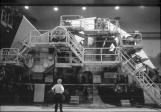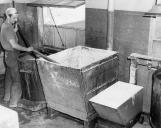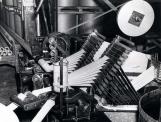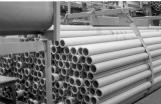44
Number 10 Paper Machine and WinderCirca 1965
Powell River, British Columbia, Canada
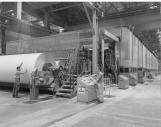 Credits:
Credits:FC114
45
It was designed to run at 3,000 feet per minute and was equipped with a data recording system that could be linked to computer. Number 10's 160,000 tons annual output boosted the Powell River mill's yearly newsprint output to 692,000 tons, keeping it in first place as the world's largest single-unit producer. It increased MacMillan, Bloedel and Powell River Company's production to over a million tons a year. In March 1973 No. 10 was operated at 3,000 feet per minute and 300 inch trim continuously for 48 hours, setting a Canadian record.Bill Thompson,
The Powell River Mill Story
46
Paper Machine Computer3 March 1987
Powell River, British Columbia, Canada
 Credits:
Credits:OS065
Al Pauling
47
The new machine is 302 ft (92 m) long, some 60 feet shorter than conventional paper machines that were operating at 3,000 fpm. Designed to run at 3,500-4,000 fpm, No. 11 would have to dry the sheet even faster, but with a shorter drier section. The drier section was interrupted before the final 8-roll segment by a roll breaker calender stack, which began the calendering process before the sheet entered the final drying stage. The new Monster began turning out newsprint at 3,100 feet per minute in April 1981.48
Number 11 Paper Machine Constructioncirca 1985
Powell River, British Columbia, Canada
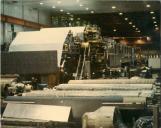 Credits:
Credits:FC028
49
#11- Into the Startup ModeAs far as #11 is concerned, we are presently in the startup mode. In the week of January 19, we started flushing and checking out equipment on the wet end, working toward the dry end. We anticipate getting into the checkout of the machine itself shortly, and flushing the lubrication system.
The whole stock preparation area is broken down into small systems, and we are flushing them one by one. We're looking for any problems with leaks or mechanical problems with pumps. When the problem areas are found, a crew comes right behind and rectifies them. We've been checking the drives for the machines over the past few weeks as well.
The month of February will be hectic. We have to complete the unfinished work, and finish the complete checkout of the systems by mid-march. Approaching fast is stage three of the checkout--when the operators actually have their hands on. This could be ready to occur on some systems by the third week of February.
Powell River Penstock
Vol. 5, No. 1
March, 1981
Historical Note:
By the end of the year, No. 11 was the fastest paper machine in Canada, running at 3,510 feet per minute (a mile of paper every 90 seconds, or 40 miles per hour). In August 1983 it set a world record for one month's production. In 1985 the big machine was rated the best in the world. No. 10 made the world's top ten.
51
Dextrine Glue and Its PreparationBy Hudson Pirie
A lot of you no doubt have seen the big cans of brown, syrupy looking glue we use in the Finishing Room for applying the wrappings on the roll of newsprint. Have you ever stopped to think just how and what glue is made from?
There are many and various kinds, too numerous to mention, but as we use a large amount of what is known as "dextrine" glue, lets see just what kind of stuff it is. The original form of this glue is - believe it or not - corn.
In initial manufacture, the corn, after being mixed with an acid to make it more soluble, is heated to about 235 degrees F., and when dried, is ground into powder form and put into sacks in which form it is received here.
In preparing this type of glue for use, an alkali is usually added along with various ingredients to make the dextrine stickier and faster drying, borax and caustic flakes being used here. The caustic about 3 pounds and borax 35 pounds is mixed in a large steel drum in a small amount of water.
The drum is then filled with water and 200 pounds of dextrine added. Steam is then injected which heats and breaks up the ingredients, while being stirred continuously. This makes up a batch of 660 pounds. After cooling the glue is then ready for use.
Men and Paper
Vol. 1, No. 46
March 29, 1947
53
Core Roll Machine Attracts VisitorsBy Hudson Pirie
After the core stock rolls are manufactured during a wrapper run on one of the paper machines, they are cut up on a rewinder into strips or bands 4 inches wide and about 30 inches in diameter, 12 strips in width per roll.
These rolls are then broken down at the core machine into the individual strips and cleaned, then placed on spools on a rack which holds about 25 of these strips. A standard core will run about 20 of these at one time during the manufacture. The strips are run through a bath of glue and finally met, one on top of the other, on a steel core or shaft coming off in a spiral formation. The strips are kept tight by belts running over the outside bands to insure good adhesion.
The cores come out of the machine into a trough which keeps the core running straight until it reaches a length of 72 ft. when an automatic stop cuts the power and the core is cut off. These cores are piled in a rack holding about 300 finished lengths through which warm air is circulating at all times to ensure thorough drying. The cores are moved every day to make sure the oldest ones are used first. These long cores are cut into the required or programmed length by a "core cutter" using a special ground saw which makes a clean cut, free of ragged edges, which might interfere with the winding.
Men and Paper
Vol. 1, No. 29
November 30, 1946
55
An interview from the Finishing RoomI've heard stories of people who stuck messages or cartoons in the cores. Did you ever hear of anyone communicating that way?
"Oh ya, those things were going on. You could see how the messages people stuffed into the cores were lost; because once the roll got to a newspaper, before it was used the ends were cut off straight away and thrown out, and that's where the messages were hidden."
"All this stuff went all over the world. We used to have a little thing they started out, where they finished the paper, put the wrapper on them and get them ready to ship out, it was called the snooze can news, and in those days a lot of the guys chewed tobacco in there. They'd clean out the snooze can, then they'd stick it in the core of the roll, put the plugs in, then when it got to where it was going, the guys would be punching the lip plugs out of the cores, and out would come this can, and they'd open it up there'd be a little write up about what was going on, and then they started sending things back. That went on for quire a few years there. People got to meet people in other parts of the world through that sort of thing."
Transcript of interview tape
People of the White City
57
The Company's Penstock magazine of February 1979 announced a $163 Million Investment for Powell River which would increase the mill's paper production by 193,000 tonnes, bringing the Company's total annual newsprint capacity (including Port Alberni mill) to 1.4 million tonnes. Bruce Howe, Company Vice-President, said No. 11 Machine was expected to be profitable, productive and competitive in cost, paper quality and technology into the 21st century. It was the first major expansion of B.C.'s newsprint industry in 10 years and was expected to provide about 100 permanent jobs and make the mill more efficient by making better use of each log. Other newsprint producers in B.C. and United States had already announced plans to increase capacity.By April the project was well under way, employing some 100 workers-increasing to 500 by the following spring and eventually to 700. Premier Bill Bennett officially started the work by using a front-end loader to dump a load of dirt into a truck.
No. 11 Paper Machine, a 300-inch-trim Bel Baie model from Benoit Canada Ltd., was the largest part of the expansion program, which included a new core-manufacturing plant, using modern computer and laser technology, and two new, Canadian-made TMP lines of improved design. Total TMP production would increase to 750 tonnes per day. A new 60-megawatt electrical substation would supply power to the TMP lines. The new paper machine and TMP lines were housed in steel-framed structures adjacent to Nos. 9 & 10 Machines. New finishing facilities for Nos. 9-11 Machines were required, as well as a new warehouse of 3,000 tonnes capacity to handle the increased production.
The Powell River Mill Story,
Bill Thompson, 2001
